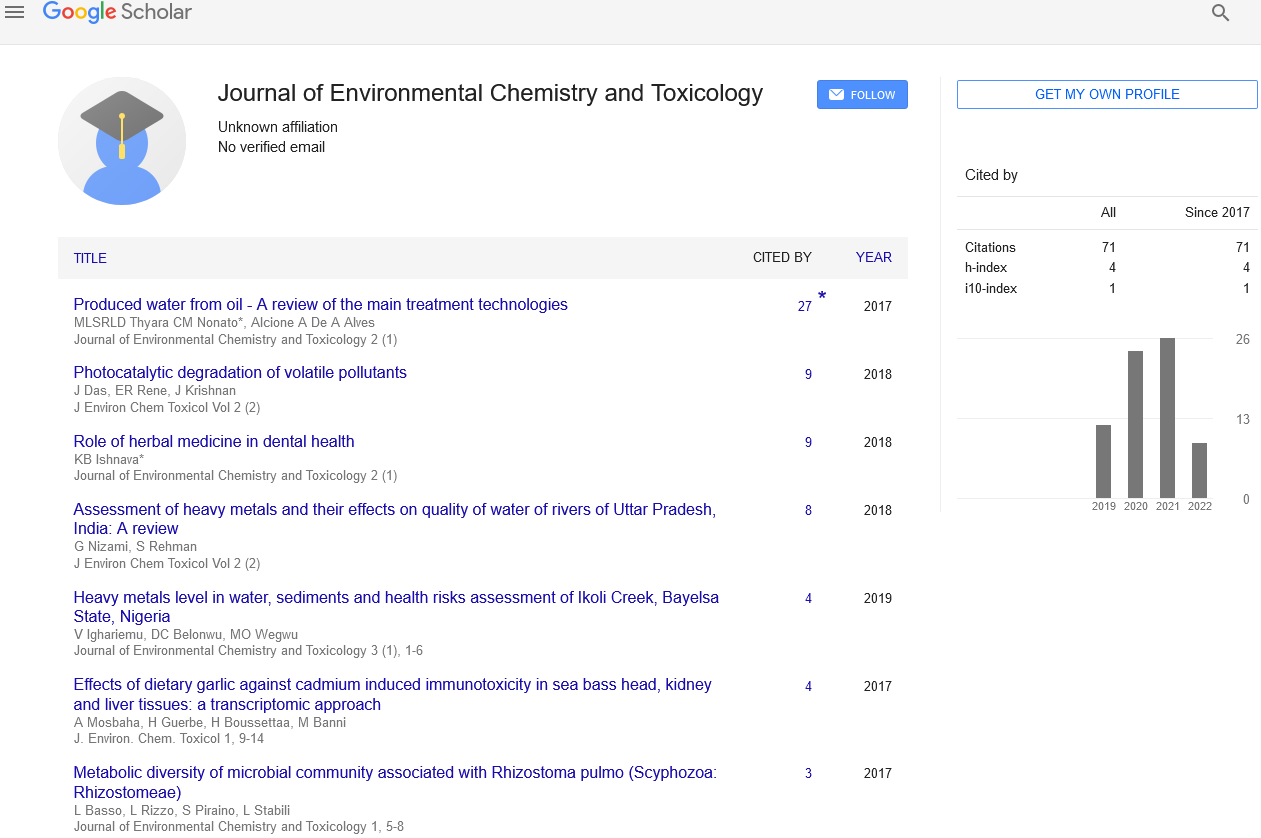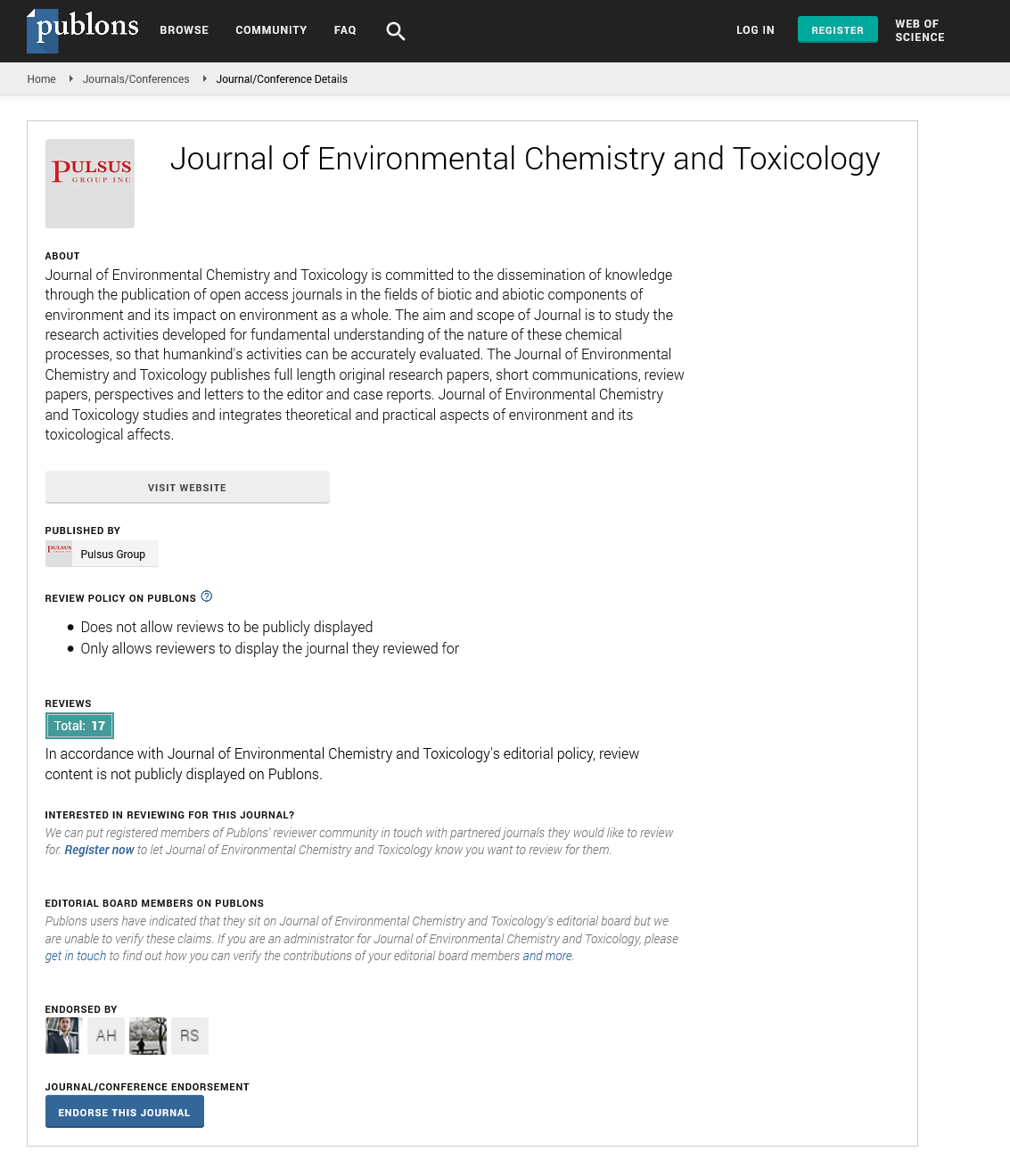Toxicology of marine plastic
Received: 04-Jul-2022, Manuscript No. PULJECT-22-4930; Editor assigned: 12-Jul-2022, Pre QC No. PULJECT-22-4930(PQ); Accepted Date: Jun 18, 2022; Reviewed: 14-Jul-2022 QC No. PULJECT-22-4930(Q); Revised: 16-Jul-2022, Manuscript No. PULJECT-22-4930(R); Published: 24-Jul-2022, DOI: 10.37532/pulject.2022.6(4);21-22
Citation: Thomson L.Toxicology of Marine Plastic. J Environ Chem Toxicol. 2022; 6(4):21-22.
This open-access article is distributed under the terms of the Creative Commons Attribution Non-Commercial License (CC BY-NC) (http://creativecommons.org/licenses/by-nc/4.0/), which permits reuse, distribution and reproduction of the article, provided that the original work is properly cited and the reuse is restricted to noncommercial purposes. For commercial reuse, contact reprints@pulsus.com
Abstract
Over the ultimate decades, it has grown to be clean that plastic pollutants afford a worldwide societal and environmental undertaking given its growing presence withinside the oceans. Developing literature has targeted the microbial existence developing at the surfaces of those pollution known as the “plastisphere,” however the fashionable standards of microbial ecotoxicology have most effectively hardly ever been integrated. Microbial ecotoxicology offers the effect of pollution on microbial groups and inversely and how great a deal microbes can affect their biodegradation. The purpose of this assessment is to enlighten the developing literature on the ultimate 15 years of microbial ecotoxicology associated with plastic pollutants withinside the oceans. First, we attention to the effect of plastic on marine microbial existence and the numerous features it guarantees withinside the ecosystems. In this part, we additionally speak about the riding elements influencing biofilm improvement on plastic surfaces and the ability to function of plastic particles as a vector for dispersal of dangerous pathogen species. Second, we supply a crucial view of the quantity to which marine microorganisms can take part withinside the decomposition of plastic withinside the oceans and of the relevance of modern trendy assessments for plastic biodegradability at sea. We spotlight a few examples of metabolic pathways of polymer biodegradation. We finish with numerous questions concerning gaps in modern expertise of plastic biodegradation with the aid of using marine microorganisms and the identity of feasible.
Introduction
The quantity of land-primarily based plastic particles getting into the sea is expected at 4. eight to 12.7 million lots in keeping with years. It is so crucial that plastic appears as a marker of the Anthropocene. A developing frame of studies has investigated plastic distribution and toxicity for marine fauna. A relatively smaller however developing literature has been committed to the microbial ecotoxicology of marine plastic particles, i.e.
- The effect of plastic on marine microbial lifestyles collectively with the numerous atmosphere offerings that marine microbial lifestyles guarantees and inversely
- The position of microorganisms inside the degradation of ocean plastic. Both components can be successively explored with the aid of using this assessment, which covers the final 15 years of literature.
In the research of microorganisms colonizing plastic surfaces the use of current strategies of huge DNA sequencing changed into added most effective recently. The authors added the world “plastisphere” to explain the microbial lifestyles developing on those surfaces. They additionally detected individuals of the probably pathogenic genus Vibrio, which can be dispersed over long distances with the aid of using floating chronic plastics. Since then, numerous research investigated numerous marine environments, which includes the North Pacific Gyre and the Mediterranean Sea. In parallel, developing literature defined the primary steps of colonization of the latest plastic till the formation of a mature biofilm. Such understanding is of first-rate hobby to higher apprehend the effect of plastic on marine microbial lifestyles and atmosphere functions. Only one has a look at this point used shotgun metagenomics, displaying that plastic-inhabiting microbes gift an enriched gene repertoire as compared to microbes residing withinside the surrounding waters. In this assessment, we argue that present-day understanding is inadequate to attract a clean photograph of the effect of plastic on marine microbial lifestyles and atmosphere functions, and we endorse numerous guidelines for similar research in this field. The position of microbes on plastic degradation withinside the ocean is a 2d problem of concern. Very recently, a tremendous complete assessment concluded that “present-day global requirements and local check strategies are inadequate of their capacity to realistically are expecting the biodegradability of provider baggage in a marine environment, because of numerous shortcomings in experimental methods and a paucity of facts withinside the medical literature”. The functionality of microorganisms to biodegrade plastic changed into pronounced for several bacterial lines. Fungi additionally have the functionality to biodegrade plastics, however, a maximum of the research has been carried out in terrestrial conditions while only a few research to this point exists in marine conditions. Moreover, maximum of the research has been primarily based totally on the choice and checking out of unmarried lines in laboratory conditions, which may be very a long way from environmental conditions. In this assessment, we underscore the understanding gaps in plastic biodegradation with the aid of using marine microorganisms and we strive to pick out feasible guidelines for destiny studies in this area (see section “How Much Can Microorganisms Participate in Plastic Due to their microbial origin, PHAs have been located to be biodegradable in lots of environments including soil, marine ecosystems, or sewage sludge. Biodegradation of Poly (3-hydroxybutyrate-co-3-hydroxyhexanoate) has been demonstrated with similar costs to that of cellulose, with quicker degradation located beneath neath cardio (eighty-five days) as compared to anaerobic (6 months) situations. The biodegradation scheme indicates the exclusive steps of PHB biodegradation. When the biodegradation isn't always completed withinside the cells through microorganisms that produce their PHB, different microorganisms provoke the biodegradation of PHB withinside the medium through outside hydrolysis and the use of ectoenzymes that convert the polymers into hydroxylated acid monomers of Hydroxy Butyrate (HB). This molecule is water-soluble and small sufficient to passively diffuse throughout the bacterial membrane and input the βoxidation cycle. The ensuing acetyl-CoA may be oxidized withinside the TCA cycle till the very last mineralization. PHA-degradation has been demonstrated withinside the laboratory beneath neath cardio or anaerobic situations. The dominant microorganism in cardio marine situations belongs to Clostriales, Gemmatales, Phycisphaerales, and Chlamydiales, while Cloacamonales and Thermotogales dominate in anaerobic sludge.
Keywords
Plastisphere






